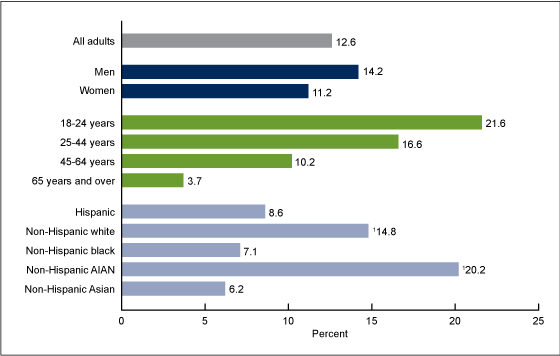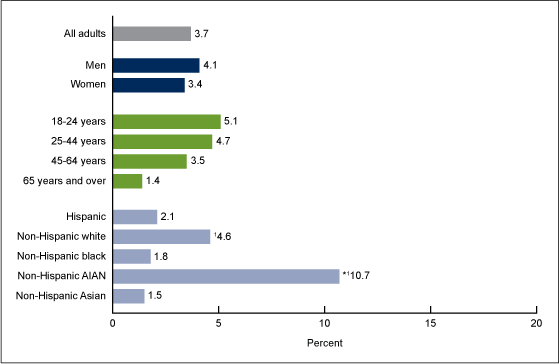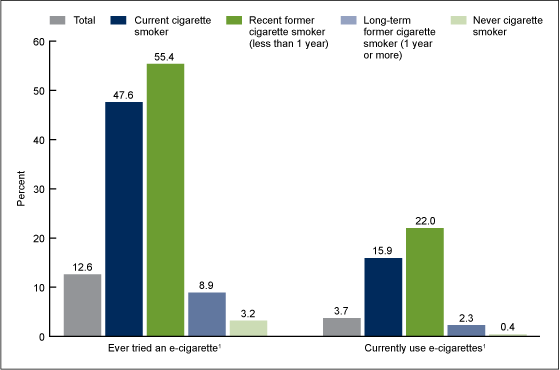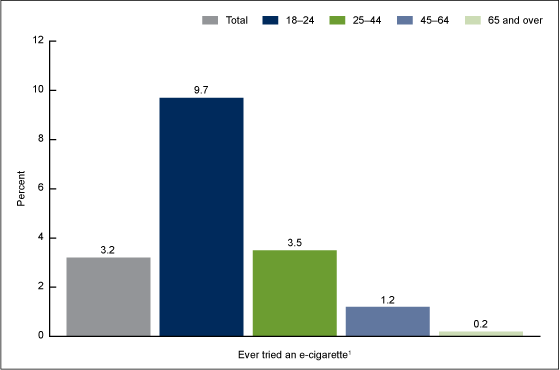Electronic Cigarette Use Among Adults: United States, 2014
NCHS Data Brief No. 217, October 2015
On This Page
- Key findings
- In 2014, 12.6% of adults had ever tried an e-cigarette even one time in their lifetimes, with use differing by sex, age, and race and Hispanic or Latino origin.
- About 3.7% of adults currently used e-cigarettes every day or some days, with use differing by age and race and Hispanic or Latino origin.
- Current cigarette smokers and recent former smokers (quit smoking within the past year) were more likely to use e-cigarettes than long-term former smokers (quit smoking more than 1 year ago) and adults who had never smoked.
- Current cigarette smokers who had tried to quit in the past year were more likely to use e-cigarettes than those who had not tried to quit.
- Among adults who had never smoked cigarettes, young adults aged 18–24 were more likely than older adults to have tried e-cigarettes.
- Summary
- Definitions
- Data source and methods
- About the authors
- References
- Suggested citation
PDF Version (697 KB)
Charlotte A. Schoenborn, M.P.H.; and Renee M. Gindi, Ph.D.
Key findings
Data from the National Health Interview Survey
- In 2014, 12.6% of adults had ever tried an e-cigarette even one time, with use differing by sex, age, and race and Hispanic or Latino origin.
- About 3.7% of adults currently used e-cigarettes, with use differing by age and race and Hispanic or Latino origin.
- Current cigarette smokers and former smokers who quit smoking within the past year were more likely to use e-cigarettes than former smokers who quit smoking more than 1 year ago and those who had never smoked.
- Among current cigarette smokers who had tried to quit smoking in the past year, more than one-half had ever tried an e-cigarette and 20.3% were current e-cigarette users.
- Among adults who had never smoked cigarettes, 3.2% had ever tried an e-cigarette. Ever having used an e-cigarette was highest among never smokers aged 18–24 (9.7%) and declined with age.
Electronic cigarettes (e-cigarettes) are battery-powered products that typically deliver nicotine in the form of an aerosol (1). E-cigarettes have been marketed as both a smoking cessation tool and an alternative to conventional cigarettes (2). Results from several studies suggest recent rapid increases in e-cigarette use (3–7). In light of ongoing declines in conventional cigarette smoking prevalence (8), it is important to understand the extent to which e-cigarettes are being used among U.S. adults, both overall and by conventional cigarette smoking status. This report provides the first estimates of e-cigarette use among U.S. adults from a nationally representative household interview survey, by selected demographic and cigarette smoking characteristics.
Keywords: electronic nicotine delivery system (ENDS), e-cigarettes, National Health Interview Survey
In 2014, 12.6% of adults had ever tried an e-cigarette even one time in their lifetimes, with use differing by sex, age, and race and Hispanic or Latino origin.
- Men were more likely than women to have ever tried an e-cigarette (Figure 1).
- More than 20% of adults aged 18–24 had ever tried an e-cigarette, with use declining steadily as age increased.
- Non-Hispanic American Indian or Alaska Native (AIAN) adults (20.2%) and non-Hispanic white adults (14.8%) were more likely than Hispanic (8.6%), non-Hispanic black (7.1 %), and non-Hispanic Asian (6.2%) adults to have ever tried an e-cigarette.
Figure 1. Percentage of adults who had ever tried an e-cigarette in their lifetime, by sex, age, and race and Hispanic or Latino origin: United States, 2014
1Significantly different from Hispanic, non-Hispanic black, and non-Hispanic Asian subgroups.
NOTES: AIAN is American Indian or Alaska Native. Within sex and age groups, all subgroups are significantly different from each other. There is a significant linear trend by age group.
SOURCE: CDC/NCHS, National Health Interview Survey, 2014.
About 3.7% of adults currently used e-cigarettes every day or some days, with use differing by age and race and Hispanic or Latino origin.
- Current use of e-cigarettes was about the same for men and women (Figure 2).
- Current e-cigarette use was higher among non-Hispanic AIAN adults (10.7%) and non-Hispanic white adults (4.6%) than among Hispanic (2.1%), non-Hispanic black (1.8%), and non-Hispanic Asian (1.5%) adults.
Figure 2. Percentage of adults who currently use e-cigarettes, by sex, age, and race and Hispanic or Latino origin: United States, 2014
* Estimate has a relative standard error greater than 30% but less than 50% and does not meet standards of reliability or precision. The 95% confidence interval is 5.3–20.4.
1Significantly different from Hispanic, non-Hispanic black, and non-Hispanic Asian subgroups.
NOTE: AIAN is American Indian or Alaska Native.
SOURCE: CDC/NCHS, National Health Interview Survey, 2014.
Current cigarette smokers and recent former smokers (quit smoking within the past year) were more likely to use e-cigarettes than long-term former smokers (quit smoking more than 1 year ago) and adults who had never smoked.
- Almost one-half of current cigarette smokers (47.6%) and more than one-half of recent former cigarette smokers (55.4%) had ever tried an e-cigarette, compared with 8.9% of long-term former smokers and 3.2% of adults who had never smoked cigarettes (Figure 3).
- About one in six current cigarette smokers (15.9%) and nearly one in four recent former cigarette smokers (22.0%) currently used e-cigarettes, compared with 2.3% of long-term former cigarette smokers and 0.4% of adults who had never smoked cigarettes.
Figure 3. Percentage of adults who had ever tried and percentage who currently use e-cigarettes, by cigarette smoking status: United States, 2014
1Percentages were significantly different across all smoking status groups.
NOTES: Current e-cigarette users have ever tried an e-cigarette, even once, and currently use them every day or some days. Current cigarette smokers have ever smoked 100 cigarettes in their lifetime and currently smoke every day or some days. Based on household interviews with adults aged 18 and over.
SOURCE: CDC/NCHS, National Health Interview Survey, 2014.
Current cigarette smokers who had tried to quit in the past year were more likely to use e-cigarettes than those who had not tried to quit.
- Current cigarette smokers who had tried to quit smoking in the past year were more likely than smokers who had not tried to quit to have ever tried an e-cigarette (Figure 4).
- Current cigarette smokers who had tried to quit in the past year (20.3%) were almost twice as likely as cigarette smokers who had not tried to quit (11.8%) to currently use e-cigarettes.
Figure 4. Percentage of adult current cigarette smokers who had ever tried and percentage who currently use e-cigarettes, by past year cigarette smoking quit attempt status: United States, 2014
1Percentages are significantly different across quit attempt groups.
NOTES: Current e-cigarette users have ever tried an e-cigarette and currently use them every day or some days. Information is not available on whether e-cigarettes were used before or after the quit attempt. Based on household interviews with adults aged 18 and over.
SOURCE: CDC/NCHS, National Health Interview Survey, 2014.
Among adults who had never smoked cigarettes, young adults aged 18–24 were more likely than older adults to have tried e-cigarettes.
- Among adults who had never smoked cigarettes, the percentage who had ever tried an e-cigarette, even one time, was highest for those aged 18–24 (9.7%) and declined as age increased (Figure 5).
- Among adults aged 45 and over who had never smoked cigarettes, 1% or less had ever tried an e-cigarette even once.
Figure 5. Percentage of adults who had never smoked cigarettes and who had ever tried an e-cigarette, by age: United States, 2014
1Significant linear trend for age.
NOTES: Adults who had never smoked cigarettes includes those who had smoked fewer than 100 cigarettes in their lifetime. Based on household interviews with adults aged 18 and over.
SOURCE: CDC/NCHS, National Health Interview Survey, 2014.
Summary
The National Health Interview Survey (NHIS) first began collecting data about e-cigarette use in 2014. The estimates presented in this report provide a foundation for understanding who is using e-cigarettes and for monitoring changes in e-cigarette use among U.S. adults over time.
In 2014, men were more likely than women to have ever tried e-cigarettes but were not more likely to be current users. Younger adults were more likely than older adults to have tried e-cigarettes and to currently use e-cigarettes. Both non-Hispanic AIAN and non-Hispanic white adults were more likely than non-Hispanic black, non-Hispanic Asian, and Hispanic adults to have ever tried e-cigarettes and to be current e-cigarette users.
When examined in the context of conventional cigarette smoking, use of e-cigarettes was highest among current and recent former cigarette smokers, and among current smokers who had made a quit attempt in the past year. Although fewer than 4% of adults who had never smoked conventional cigarettes had ever tried an e-cigarette, nearly 1 in 10 never-smokers aged 18–24 had tried an e-cigarette at least once.
Definitions
Cigarette smoking status: Adults were asked if they had smoked at least 100 cigarettes in their lifetime and, if yes, whether they currently smoked cigarettes every day, some days, or not at all. Those who smoked every day or some days were classified as current smokers. Adults who had not smoked 100 cigarettes were classified as having never smoked. Adults who had smoked 100 cigarettes but were not smoking at the time of interview were asked how long ago they last smoked. Former smokers were then classified as recent former smokers (quit within the past year) or long-term former smokers (quit at least 1 year earlier).
E-cigarette use: Use of e-cigarettes was determined by first describing an e-cigarette for the respondent (“The next questions are about electronic cigarettes, often called e-cigarettes. E-cigarettes look like regular cigarettes, but are battery-powered and produce vapor instead of smoke.”). The respondent was then asked, “Have you ever used an e-cigarette, even one time?” Those who said “yes” were referred to as having “ever tried an e-cigarette.” Adults who had ever used an e-cigarette, even one time, were then asked, “Do you now use e-cigarettes every day, some days, or not at all?” Current e-cigarette use includes respondents who reported using e-cigarettes every day or some days.
Quit attempt: Adults who were current cigarette smokers were asked if they had stopped smoking cigarettes for more than 1 day in the past year because they were trying to quit smoking. Smokers responding “yes” were classified as having made a quit attempt in the past year.
Race and Hispanic or Latino origin: The revised 1997 Office of Management and Budget standards for race (9) were used for the classification of race and Hispanic or Latino origin. A person’s race is described by one or more of five racial groups: white, black or African American, American Indian or Alaska Native, Asian, and Native Hawaiian or Other Pacific Islander. Data on race and Hispanic or Latino origin are collected separately but combined for reporting. Not shown separately are data for Native Hawaiian or Other Pacific Islander, and for persons of two or more races, due to small sample sizes. Persons of Hispanic or Latino origin may be of any race.
Data source and methods
Data from the 2014 NHIS were used for this analysis. NHIS data are collected continuously throughout the year for the Centers for Disease Control and Prevention’s (CDC) National Center for Health Statistics (NCHS) by interviewers from the U.S. Census Bureau. NHIS includes information about the health characteristics and health care of the civilian noninstitutionalized population of the United States. Questions about lifetime and current e-cigarette use were first asked in NHIS in 2014, in the Sample Adult component (n = 36,697). The questions followed a series of questions on use of conventional cigarettes, noncigarette combustible tobacco, and smokeless tobacco products.
Estimates in this report are nationally representative of civilian adults aged 18 and over living in households across the United States. SAS-callable SUDAAN software was used to produce estimates and variances. Differences between percentages were evaluated using two-sided significance tests at the 0.05 level. Estimates with a relative standard error greater than 30% but less than 50% are indicated with an asterisk. Cochran-Mantel-Haenszel tests for trend were used to evaluate trends in e-cigarette use across age groups.
About the authors
Charlotte A. Schoenborn and Renee M. Gindi are with CDC’s National Center for Health Statistics, Division of Health Interview Statistics.
References
- Grana R, Benowitz N, Glantz SA. Background paper on e-cigarettes (electronic nicotine delivery systems). Center for Tobacco Control Research and Education, University of California, San Francisco, a WHO Collaborating Center on Tobacco Control. Prepared for WHO Tobacco Free Initiative. 2013.
- Grana RA, Ling PM. “Smoking revolution”: A content analysis of electronic cigarette retail websites. Am J Prev Med 46(4):395–403. 2014.
- King BA, Alam S, Promoff G, Arrazola R, Dube SR. Awareness and ever-use of electronic cigarettes among U.S. adults, 2010–2011. Nicotine Tob Res 15(9):1623–7. 2013.
- McMillen R, Maduka J, Winickoff J. Use of emerging tobacco products in the United States. J Environ Public Health 2012:989474. 2012.
- Pearson JL, Richardson A, Niaura RS, Vallone DM, Abrams DB. E-cigarette awareness, use, and harm perceptions in US adults. Am J Public Health 102(9):1758–66. 2012.
- Zhu SH, Gamst A, Lee M, Cummins S, Yin L, Zoref L. The use and perception of electronic cigarettes and snus among the U.S. population. PLoS ONE 8(10):e79332. 2013.
- Agaku IT, King BA, Husten CG, Bunnell R, Ambrose BK, Hu SS, et al. Tobacco product use among adults—United States, 2012–2013. MMWR 63(25):542–7. 2014.
- National Center for Health Statistics. Health, United States, 2014: With special feature on adults aged 55–64. Hyattsville, MD. 2015.
- Office of Management and Budget. Revisions to the standards for the classification of federal data on race and ethnicity. Fed Regist 62(210):58782–90. 1997.
Suggested citation
Schoenborn CA, Gindi RM. Electronic cigarette use among adults: United States, 2014. NCHS data brief, no. 217. Hyattsville, MD: National Center for Health Statistics. 2015.
Copyright information
All material appearing in this report is in the public domain and may be reproduced or copied without permission; citation as to source, however, is appreciated.
National Center for Health Statistics
Charles J. Rothwell, M.S., M.B.A., Director
Nathaniel Schenker, Ph.D., Deputy Director
Jennifer H. Madans, Ph.D., Associate Director for Science
Division of Health Interview Statistics
Marcie L. Cynamon, Director
Stephen J. Blumberg, Ph.D., Associate Director for Science
- Page last reviewed: October 28, 2015
- Page last updated: October 28, 2015
- Content source:


 ShareCompartir
ShareCompartir




